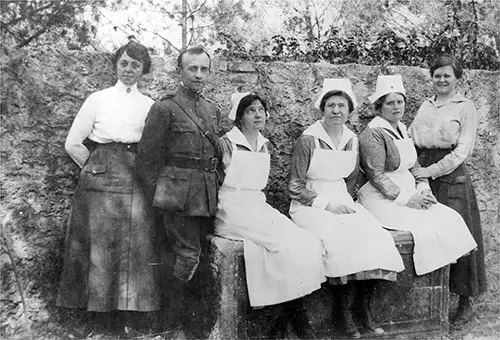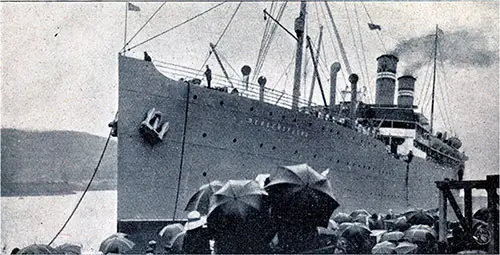Possible Origins of the Spanish Influenza - 1918

Flu Fighters in Montenegro. They Went to Montenegro to Fight Smallpox, and Typhus Epidemics and When Influenza Broke out There Had Their Hands Full Taking Care of the Victims of the Newer Epidemic. They Belong to the American Red Cross Hospital Staff in Podgoritza, Montenegro. From Left to Right They Are: Miss Margaret Lena Johnson, Chicago; Major Joseph F. Jaros, Chicago; Miss Mary Theresa Beulhauser, New York; Miss Elizabeth G. Mitchell, Newport R.I. and Dr. Katherine M. Cook, New Wilmington, Pa. nd. circa 1918-1919. Library of Congress # 2017671695. GGA Image ID # 1502151842
By H. H. Satchwell, Chief Physician.
Early in the spring you probably saw in the paper's accounts to the effect that the German Spring Drive was delayed by a large number of cases of sickness caused by Spanish influenza.
This disease Spread over a considerable part of Europe and about three months ago made its appearance among passengers on Transatlantic steamers arriving in New York.
The cases which attracted the most attention occurred on the Norwegian steamer "Bergensfjord," which arrived in New York after having had more than 200 cases of sickness and four deaths, during the voyage.

Departure of the SS Bergensfjrod from Kristiania (Oslo). GGA Image ID # 12306f2658
A number of passengers were transferred to a hospital in Brooklyn, and these cases which were observed by Dr. Edward E. Cornwall were ordinary cases resembling influenza. There was apparently nothing about them to justify the coinage of the new name.
Dr. A. M. Fernandez-Ybarra, of New York, was in Madrid in April when the so-called "Spanish Influenza" broke out in that city, the first place in Spain to suffer from it. He studied the epidemic in its spread through Spain.
It is his opinion that the war on the Western front in France has nothing to do with the disease, and also that the disease is neither new nor extraordinary, but is simply our old friend, "Grippe."
It is at present attacking the inhabitants of Cuba and is known there by the Spanish name "trancazo," which means a blow with a heavy stick. This well describes the onset of the disease.
Influenza is a disease due to a germ. It spreads rapidly and is highly contagious. It usually starts with fever, perhaps preceded by a chill, coughing, sneezing, running eyes and nose. You have all probably had sometime during the winter a disease with these symptoms.
I wish to call your attention to the fact that it is more than an ordinary "cold," and sometimes leads to severe and serious complications. It is spread probably by the discharges from nose and mouth, through the means of using common drinking cups, and other eating utensils, handkerchiefs, kissing, etc.
The measures Suggested to Ward off the disease or prevent its development in a severe form are those you define as a means of keeping in good health. Crowded places should be avoided. Get out of dark, damp and poorly ventilated rooms.
Those with severe colds should see that handkerchiefs after becoming soiled are immediately boiled. Cooking utensils should be scalded or boiled. The common drinking cup should be avoided. If you become sick at home, go to bed and remain away from work until cured.
Remember that the Other members of your family may contract this disease. If you become sick at the plant with what appears to be a bad cold, report to the Hospital for treatment or advice.
Remember that when sick your wages stop. You need the money and we need the ships. Play safe. Do not be frightened by a new name of an old disease but take care.
H. H. Satchwell, M.D., "Spanish Influenza," in Speed-Up: Official Weekly of the Submarine Boat Corporation, Vol. I, No. 35, 21 September 1918, p.12
